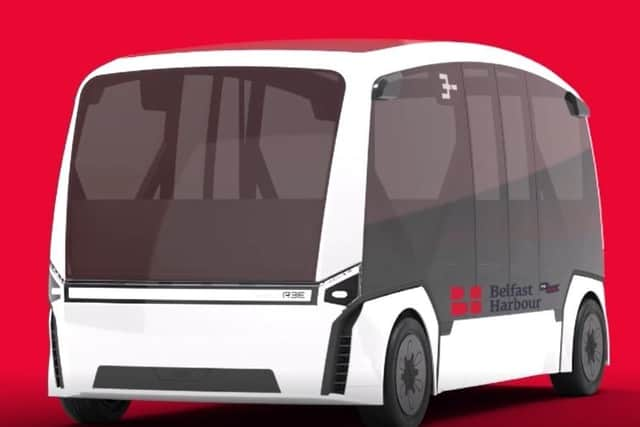Driverless bus service will soon start carrying passengers in east Belfast announce harbour bosses
and live on Freeview channel 276
It has been described by Belfast Harbour (the public body body running the city’s wider port area) as “one of the first fully driverless transport systems anywhere in the UK”.
Known as the ‘Harlander’ project, it will convey up to 16 passengers at a time from the Titanic Quarter railway halt (formerly known as Bridge End) to the Catalyst Science Park – a journey of roughly one mile by road each way.
Advertisement
Hide AdAdvertisement
Hide AdIt will run about every 15 minutes, starting in the last quarter of 2024.


The initiative has been awarded £5.5m in funding from Innovate UK, a public body based in Swindon.
Announcing the move, Mike Dawson, the people and corporate services director at Belfast Harbour, said “we are delighted to be establishing the UK’s first operationally ready and commercially viable deployment of a fully automated shuttle service on publicly accessible roads”.
In a statement accompanying the news, business secretary Grant Shapps said: “In just a few years’ time, the business of self-driving vehicles could add tens of billions to our economy and create tens of thousands of jobs across the UK.”
Advertisement
Hide AdAdvertisement
Hide AdIt is part of a wider UK scene which involves the government awarding almost £42 million to seven projects through the Centre for Connected and Autonomous Vehicles (CCAV) Commercialising Connected and Automated Mobility (CAM) competition.
The £42 million in government funding is being matched by a further £39 million from industry.
In the case of the Harlander, this means the £5.5 million awarded by government is matched by industry to a total of £11 million.
Firms working on the project include Horiba MIRA Ltd, Angoka Ltd, and REE Automotive UK Ltd.
Angoka handles cyber security technology.
Horiba MIRA designs chassis.
REE meanwhile has designed a vehicle base called P7.
BT is also involved in the scheme as well.
Advertisement
Hide AdAdvertisement
Hide AdBelfast port is just one of four ports in the Province (the others being Larne, Foyle, and Warrenpoint) but handles some 70% of all Northern Ireland’s imports and exports.
The notion of a driverless vehicle service for the area has been touted for some time, and globally a number have already been trialled.
But as with any new technology, there have been accidents.
Back in 2017, Las Vegas’ self-driving shuttle bus service was involved in a crash on its first day of operation (though this was blamed on the lorry driver who struck the bus).
The first driverless fatality was in 2018 in Arizona, when a pedestrian – Elaine Herzberg – was hit by a driverless Uber test car. A backup driver was onboard but did not react in time to avoid the crash.
Advertisement
Hide AdAdvertisement
Hide AdIn August 2021, an automated bus in the Tokyo paralympic village struck a visually-impaired athlete (albeit at a speed reported to be as low as 1mph), knocking him over.
The CEO of Toyota (which was behind the bus project), Akio Toyoda, was quoted as saying afterwards that “it shows that autonomous vehicles are not yet realistic for normal roads”.
In December 2021, an autonomous transit bus crashed in Ontario, Canada, leaving the sole occupant – its operator – seriously injured.
However, this was said not to be down to the automated brain of the vehicle; local police were quoted as saying that it had been in manual mode at the time, and so the “hazard mitigation safety systems designed for the vehicle while in autonomous mode were disabled”.
Advertisement
Hide AdAdvertisement
Hide AdLast year the UK government said that “vehicles will undergo rigorous testing and only be approved as self-driving when they have met stringent standards”.
More from the News Letter: